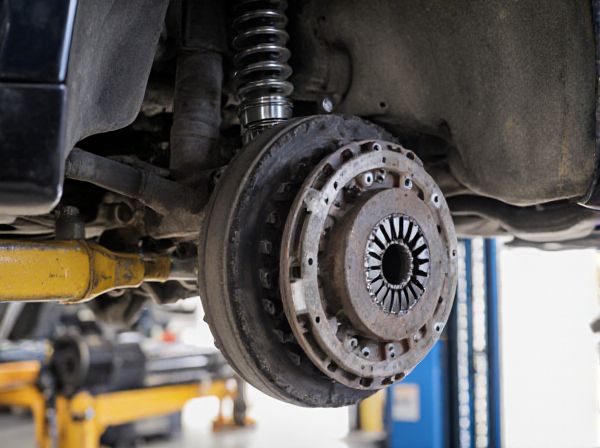
Photo illustration: Clutch Pack Differential vs Gear Train Differential
A clutch pack differential offers improved traction by modulating torque between wheels using friction plates, making it ideal for high-performance and off-road applications. Gear train differentials rely on a set of gears to distribute power evenly but may lack the dynamic grip control found in clutch packs. Understanding your vehicle's driving conditions helps determine whether a clutch pack or gear train differential better suits your needs.
Table of Comparison
| Feature | Clutch Pack Differential | Gear Train Differential |
|---|---|---|
| Mechanism | Uses friction clutches to transfer torque | Employs gears to distribute torque |
| Torque Transfer | Variable, based on clutch engagement | Constant and symmetrical torque split |
| Maintenance | Requires periodic clutch replacement | Low maintenance due to gear durability |
| Traction Control | Better traction on slippery surfaces | Limited traction control in uneven grip |
| Cost | Higher initial cost | Lower cost, simpler design |
| Common Use | Performance and off-road vehicles | Standard passenger cars and trucks |
Introduction to Differential Systems
Clutch pack differentials use multiple friction plates to control torque distribution between wheels, providing variable slip based on traction conditions. Gear train differentials rely on sets of gears, such as planetary or bevel gears, to equally split torque while allowing wheel speed differences during turns. Both systems are fundamental in enabling smooth vehicle handling and maintaining traction across varying road surfaces.
Understanding Clutch Pack Differentials
A clutch pack differential uses a series of friction plates to manage wheel torque distribution, offering variable slip control that improves traction on uneven surfaces. Unlike a gear train differential, which relies on fixed gears to divide power, the clutch pack allows for adjustable resistance, enhancing vehicle stability during acceleration and cornering. This system is particularly effective in performance and off-road applications where precise torque modulation is essential.
Understanding Gear Train Differentials
Gear train differentials use a series of gears to evenly distribute torque between wheels, allowing for smooth cornering by compensating for differences in wheel speed. Unlike clutch pack differentials that rely on friction plates to manage torque transfer, gear train differentials offer consistent performance with minimal maintenance due to their mechanical design. Understanding gear train differentials is crucial for optimizing vehicle handling and durability in various driving conditions.
Key Components and Design Differences
Clutch pack differentials utilize multiple friction clutch plates to manage torque distribution, offering variable locking based on wheel slip, which enhances traction control in high-performance or off-road vehicles. Gear train differentials rely on a set of gears, including spider gears and side gears, to evenly split torque between wheels, providing smooth power transfer and durability in standard driving conditions. The key design difference lies in the clutch pack's ability to modulate torque dynamically through friction, whereas gear train differentials depend on mechanical gear engagement for consistent torque distribution.
Functionality: How Each Differential Operates
Clutch pack differentials use multiple friction plates to regulate torque distribution between wheels, allowing controlled slippage during cornering by varying resistance based on wheel speed differences. Gear train differentials rely on a set of gears, including side gears and spider gears, to evenly split torque while permitting wheels to rotate at different speeds without slip. The clutch pack emphasizes torque modulation for traction control, whereas the gear train provides a straightforward mechanical balance of rotational speeds.
Performance Characteristics in Various Conditions
Clutch pack differentials offer enhanced traction control by modulating torque distribution between wheels, resulting in improved handling on slippery or uneven surfaces, especially in off-road and performance vehicles. Gear train differentials provide consistent torque delivery across wheels, making them reliable for standard driving conditions with smooth power transfer and durability. Performance in tight corners or low-traction scenarios is superior with clutch pack differentials due to their ability to lock selectively, whereas gear train differentials excel in longevity and simplicity under normal road conditions.
Pros and Cons of Clutch Pack Differentials
Clutch pack differentials offer superior traction control and enhanced performance in off-road and high-torque environments by allowing controlled slip between wheels, improving vehicle stability on uneven terrain. They provide quicker response and adjustable locking, but require more frequent maintenance and can suffer from heat buildup under continuous heavy load, leading to potential premature wear. Compared to gear train differentials, clutch pack systems tend to be more complex and costly but excel in customizable traction management for performance-oriented applications.
Pros and Cons of Gear Train Differentials
Gear train differentials offer robust mechanical simplicity and durability, making them ideal for heavy-duty applications where reliability is essential. However, their less precise torque distribution compared to clutch pack differentials can lead to reduced traction efficiency in high-performance scenarios. They often have lower maintenance requirements but lack the adaptability found in clutch-based systems.
Applications and Suitable Use Cases
Clutch pack differentials excel in high-performance vehicles and off-road applications due to their ability to modulate torque transfer smoothly, enhancing traction during acceleration and cornering. Gear train differentials, commonly found in standard passenger cars and heavy machinery, provide durable and consistent power distribution between wheels, making them suitable for everyday driving and heavy-load scenarios. Choosing between these differentials depends on the application requirements: clutch pack for dynamic traction control and gear train for reliability under constant load.
Clutch Pack vs Gear Train Differential: Which is Better?
Clutch pack differentials offer superior torque distribution by using friction plates that allow for controlled slip, making them ideal for performance vehicles requiring variable traction. Gear train differentials rely on a fixed arrangement of gears, providing consistent power split but less adaptability to changing traction conditions. For off-road and high-performance applications demanding responsive torque management, clutch pack differentials typically outperform gear train designs in handling and control.
 caratoz.com
caratoz.com